Freezing eggplant is a great way to store some of the season’s harvest – and to get a head start on your meal prepping this fall.
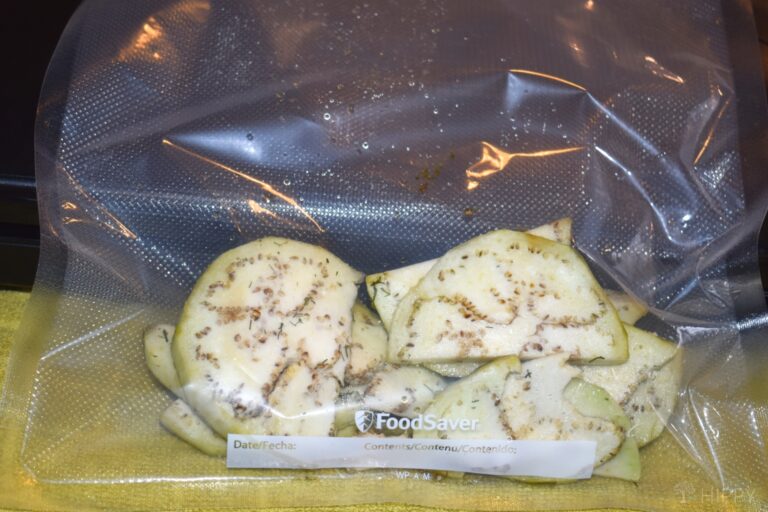
Even if you plan to cook your eggplant after thawing it out, freezing is a great way to prevent food spoilage, and to extend the bounty of your harvest into year-long enjoyment.
Here’s everything you need to know about freezing eggplant, as well as tips to make it easier.
Begin by selecting a fresh, firm eggplant. The fresher your eggplant is (ideally harvested within a week or so), the better it will handle the freezing process.
To tell whether you have a good, ripe eggplant, make sure the seeds aren’t fully mature. Obviously, you won’t be able to determine this without cutting into the vegetable, but in general, ripe eggplants will have dark, uniform colors. Avoid using eggplants with any soft or discolored spots.
You can use just about any variety of eggplant for freezing, but usually, black ones will break down slower than purple ones (like Thai and Chinese varieties).
That being said, any type will work – just keep in mind that the flesh of purple eggplant will soften more quickly after thawing. As long as you cook your eggplant immediately after you have thawed it, you should be fine.
Again, fresh eggplant is best for freezing. If time or other limitations prevent you from freezing your eggplant right away, just be sure to store it in the refrigerator until you are ready to do so.
The next step is to wash your eggplant. You will need to wash your eggplant thoroughly to remove any traces of soil or pesticides.
You are going to be peeling it, but you still want to make sure you get rid of any exterior grime. If you are having a hard time removing the build-up, you can always scrub it gently with a brush or sponge.
Is Blanching Required?
There are several methods for how to freeze eggplant. However, for most of them, blanching is recommended. Here’s why – and how.
As you slice your eggplant, you will need to drop it into a pot of hot, boiling water to blanch. Don’t wait to have all of your eggplant sliced before you blanch – this can cause it to discolor.
You won’t lose much flavor, but as little as 30 minutes of time exposed to the air can cause your vegetables to discolor and obtain an unappetizing hue.
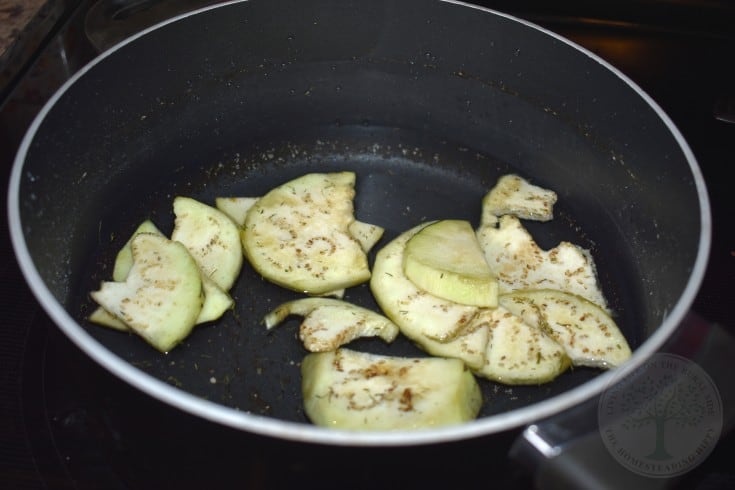
How Do You Blanch Eggplant Before Freezing?
When you blanch your eggplant, you will need to fill your pot about two-thirds of the way full with water.
Make sure the pot is large enough to accommodate all the eggplant you need to blanch, or prepare to blanch your eggplant in batches (remember, only cut small amounts at once).
If you’re really worried about discoloration, you can add about ½ cup of lemon juice to the boiling water – this ratio will work for up to one gallon of water. It won’t really affect the flavor of your eggplant but can truly make a difference in improving the color of your eggplant slices!
While your eggplant is blanching, go ahead and prepare an ice bath. You should have a bowl filled with ice water that is just as large as the stockpot you used for blanching. After boiling your eggplant for four minutes, you can dump it into the ice bath:
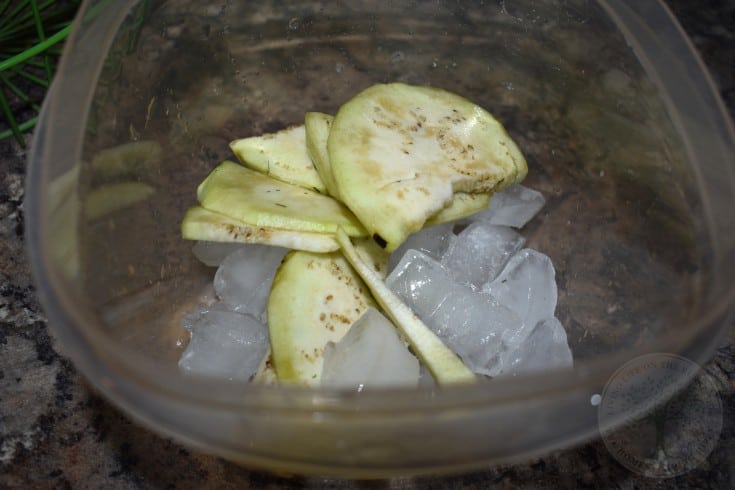
Transfer it in there as quickly as possible, which will stop the cooking process. Leave your eggplant in the ice bath for up to five minutes. You might find that you need to add more ice to maintain the temperature.
Why do you need to blanch? It’s simple. Blanching gets rid of enzymes in the eggplant that cause it to break down over time. If you don’t blanch the eggplant, it can cause it to lose nutritional value, and even color within a month of being frozen.
If you have multiple batches to blanch, don’t worry about dumping it out and reheating new pots of boiling water. You can use the old ones, just make sure you add more lemon juice as needed.
Once your eggplants have been blanched and cooled, drain them by removing them from the water with a slotted spoon and placing them on several layers of paper towels.
After you’ve blanched and cooled your eggplant, you can proceed with the rest of the recipe.
Baking Eggplant First – An Optional Step
Some people freeze eggplant by baking it first. This is completely optional, but it’s a good idea if you want to freeze eggplant that will be readymade for a meal, like eggplant parmesan – no cooking required!
Eggplant has a high water content as it is, so this can help prevent ice crystals from forming or extra mushiness when thawed.
Here’s the quick version in case you want to bake eggplant specifically for freezing.
Start by preheating your oven to 400 degrees F (200 C). Cover a baking sheet with aluminum foil.
Use a fork to pierce the eggplant a few times, which will prevent moisture and pressure build up. You don’t need to peel beforehand!
Roast it for about forty minutes – but no longer than an hour. You’ll notice that the eggplant begins to collapse.
When it’s done, you can scoop the flesh out of the inside of the eggplant. Put the flesh into airtight containers, leaving half an inch of headspace. When pre-baked, eggplant will last for one year.
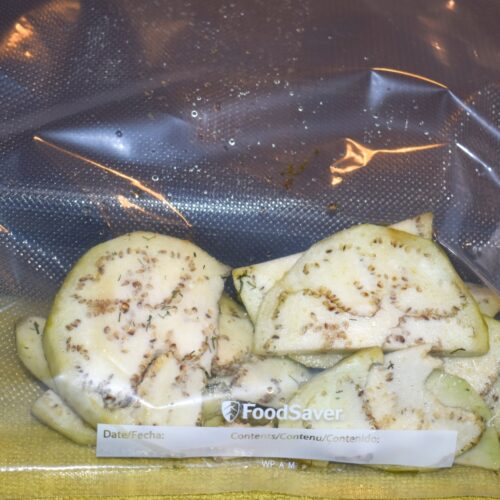
Freezing Eggplant Recipe
Ingredients
- 6 medium eggplants
- salt optional
Instructions
- Peel your eggplant by standing it on one end and peeling it from top to bottom. Then, cut your eggplant into slices that are roughly 1/3 to ¼ of an inch in thickness. You can lightly salt the eggplant to remove any lingering bitterness, if needed.
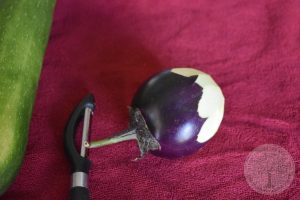
- If you are worried about your eggplant discoloration after it has been frozen and thawed, you can blanch it ahead of time. This is optional – blanching does not impact the flavor of the eggplant. To blanch, simply boil your eggplant in water on the stovetop for about three to four minutes, then cool immediately in an ice bath (bowls of ice water). Squeeze it to remove any excess liquid, which will prevent ice crystals from forming later on..
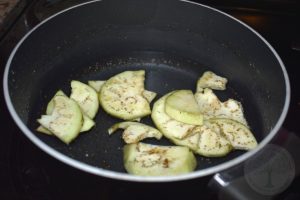
- (optional) Bake your eggplant, if you want.
- Whether you’ve chosen to blanch and / or to bake your eggplant or not, your next step will be to flash freeze. Start by laying the slices on a cookie sheet in a single layer. This will make it harder for them to stick together.
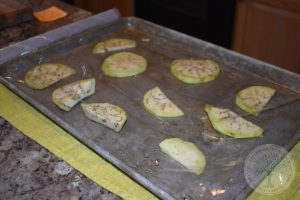
- Freeze for six to eight hours on the cookie sheet.
- Next, arrange your frozen pieces of eggplant in a freezer-safe container, like a plastic bag or a vacuum sealer bag. Never use glass containers.
Notes
- If you use a standard freezer bag, just make sure you remove as much air as possible. This will prevent freezer burn. Vacuum sealed bags tend to work best, but they do take some moisture out of the eggplant – so keep this in mind.
- If you decide to pack your eggplant into freezer-safe containers, just leave ½ inch headspace at the top to give the eggplant room to expand as it freezes.
- Always label it clearly with the date you froze it so that you will know how long your eggplant has been in the freezer.
- If you’re feeling super organized, you can even separate the eggplant slices with pieces of plastic wrap. This will allow you to easily separate the slices from each-other when you remove them from the container. It’s a great idea if you only plan on using small amounts of eggplant at a time.
Can You Also Freeze Breaded Eggplant?
You sure can! You’ll follow all the same instructions as above for slicing and blanching. However, you will need to add your bread before the flash-freezing step.
To do this, start by beating three eggs in a small bowl. In a separate bowl, add breadcrumbs and seasoning mixture spices.
Dip the slices of eggplant into the egg and then into the breadcrumb mixture.
Place them on your cookie sheet in a layer, flash freeze, and then repackage into freezer-safe bags.
Here’s the breadcrumb mixture:
- 1 tsp salt
- ½ tsp pepper
- 2 tsp Italian seasoning
- ½ tsp marjoram
- 1 cup breadcrumbs
- 3 eggs
How Do I Cook Frozen Eggplant?
Eggplant can be used in a variety of dishes, from appetizers to main course meals. When cooking frozen eggplant, simply place the desired amount of eggplant in a colander and run cold water over it to thaw.
Once thawed, pat the eggplant dry with a paper towel. Then, cut the eggplant into slices or cubes, depending on your recipe.
Some of my favorite ways to cook eggplant that I’ve frozen include:
- Eggplant lasagna (or really just eggplant with some tomato sauce and cheese!)
- Stir-frys
- Eggplant puree to be used in soups and stews
- Roasting eggplant with some garlic and olive oil
What Do I Do With Frozen Eggplant?
Eggplant will last in the freezer for about 9 months in general, but eggplant that has been stored in vacuum-sealed bags can last for 14 months.
That’s all there is to it! Freezing is easy, and it’s a fantastic way to preserve your eggplants until the next time your plants begin producing large, bountiful amounts of these delicious vegetables.
FAQ
Raw eggplant can be frozen, but it should be blanched first. Blanched eggplant will retain its color and texture when thawed, whereas un-blanched eggplant may become mushy.
The answer depends on how you’ve prepared the eggplant. If you’ve thinly sliced it or cut it into pieces, you can store it in the freezer for up to three months.
But if you’ve cooked the eggplant before freezing it, it will only last for one to two months without losing its texture and flavor.
The ideal blanching time for eggplants is three to four minutes. The cook should start timing when the eggplants are first placed in the boiling water.
Once the three to four minutes are up, the eggplants need to be immediately placed in ice water to stop the cooking process.
Eggplant should be stored in a cool, dry place. A refrigerator is ideal, but a root cellar or cool pantry will also work. Avoid storing eggplant in plastic bags, as this can cause the vegetable to sweat and become mushy.
Only store firm, unblemished eggplant, and consider wrapping it in plastic wrap or an airtight container (or preserving it in a method like freezing).
Generally speaking, raw eggplant will last about 3-4 days in the refrigerator. However, there are a few things you can do to help it last even longer. First, make sure to store your eggplant in a plastic bag or container with some ventilation.
This will help to prevent the eggplant from deteriorating too quickly. Try to keep your eggplant away from other produce items, as ethylene gas produced by other fruits and vegetables can speed up the spoilage process.
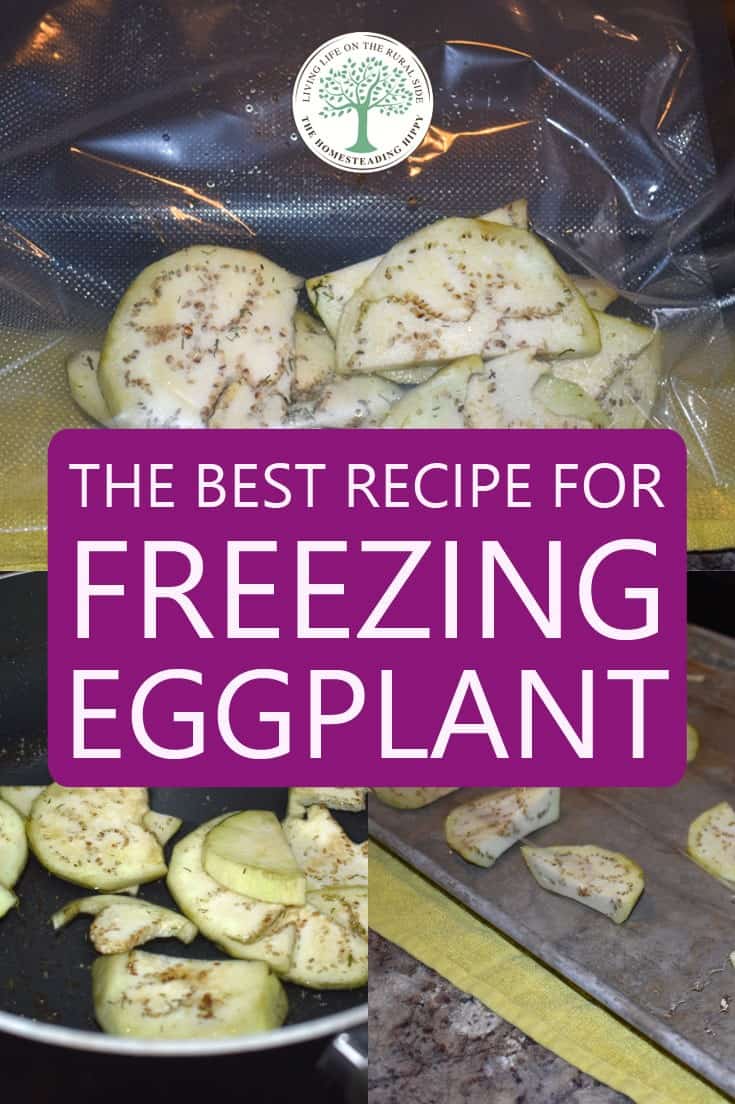

Rebekah is a full-time homesteader. On her 22 acres, she raises chickens, sheep, and bees, not to mention she grows a wide variety of veggies. She has a huge greenhouse and does lots of DIY projects with her husband in her ever-growing homesteading endeavor. Learn more about Rebekah here.

Thank You. . I always enjoy your information! !!!
Thank you so much. The instructions were easy to follow. My neighbor just bought me a full bag full. I’ve gone through each of the steps. 1. cut some up for tonight’s dinner. 2. Blanched , dated and froze some. 3. Blanched and Breaded the most. 4. But had enough to make a frozen eggplant parmesan, and yes I did date everything. Once again thank you for your help in helping me make all these meals possible.
I was hoping for more information on how to use the eggplant after I get it out of the freezer. I have Japanese eggplants, and I want to slice them lengthwise and freeze them that way without blanching. I’m hoping I can throw them on the George Foreman grill when they get out of the freezer with good results.